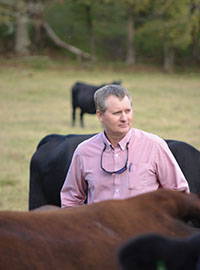Connect with Range & Pasture:
Forage Foundation Builds Healthier Herd

If you want to raise more, healthier cattle, wean heavier calves and bring more, high-quality pounds of beef to market, start by growing more, better-quality grass.
If you want to raise more, healthier cattle, wean heavier calves and bring more, high-quality pounds of beef to market, start by growing more, better-quality grass.
Regardless of cattle prices, it’s hard to argue against striving to raise and market the most pounds of beef at the lowest cost possible.
That doesn’t mean running cattle on the cheap, but it can be helpful to focus resources where they deliver the greatest return. Often, that’s in the pasture.
“Feed is the beef producer’s greatest expense. So, more low-cost grazing presents the most obvious impact on the expense side of the equation,” explains Jacee May, a Range & Pasture Specialist with Corteva Agriscience. “But forage quality and quantity impacts costs in other ways, such as labor and vet bills. Then, there’s the income column — from pounds of beef sold and the price those pounds earn.”

Veterinarians Will Carter and Monnie Carol Carter are partners in Snowdoun Veterinary Hospital in Montgomery, Alabama, and in their commercial cow-calf operation in nearby Pintlala. They’ve built their cattle business on forages.
“Grass management is the base of what we do. Everything feeds into that,” Will Carter explains. “If we don’t focus on managing the grass, we’re going to have bigger problems.”
If your aim is to bring more pounds of beef to market, a great place to start is simply through more healthier calves on the ground. And that hinges on maintaining proper cow body condition.
“If the cow is not in great body condition, she’s not cycling,” Carter explains. “If she’s not cycling, she’s not going to get pregnant.”
Maintaining cow body condition is important year-round, but especially leading up to calving. Because a cow’s top priority is its own maintenance, thin cows are less able to help their calf reach its potential.
“If she’s not in good condition, she’s not putting a lot of protein and antibodies in her colostrum,” Carter says. “So, even if a thin cow does happen to conceive, the calf will be weaker, grow less and be more likely to have health problems that stay with them all the way through the feedlot. That makes for some very unhappy customers.”
A strong vaccination program builds on the healthy start those cows give their calves, Carter says. Their marketing program requires a 60-day backgrounding period and a set of vaccines, along with thorough documentation.
“We need to be profitable long term,” he says. “The health of our calves and how they perform is vital to our success.”
Hitting their benchmarks for body condition, minimizing health complications and earning premiums at market time on a primarily forage-based ration are the Carters’ goals. They say those start with a carefully managed rotational grazing program, fertility and weed and brush control. Running cattle on healthy grasslands that aren’t overgrazed offers health benefits too.
“Not grazing to the ground prevents parasites,” Carter explains. “And by frequently rotating cattle to fresh pastures, we have way fewer fly problems. During the summer in Alabama, that’s a pretty big deal.”
Another way to increase marketable pounds of beef — one that also leans heavily on cow body condition — is by having more time to gain. A tight calving window is crucial for the Carters.
“It’s one of the things we monitor closely as an indicator our nutrition program is working,” Carter says. “It comes down to selling pounds of beef, and the easiest way to do that is age of calf. We expect 85% of our cows to calve within the first 45 days. More calves early in the calving season is much more profitable for us.”
Although the Carters set lofty goals for their cattle, they say reaching those heights must fall within the bounds of sound land stewardship. As the 2022 national winner of the Environmental Stewardship Award, Carter Cattle Company, LLC, is staying true to that commitment.
“We believe in a holistic view,” Carter says. “Our primary goal is to grow more, better-quality grass so that we can increase stocking rates, raise healthier cattle and wean heavier calves. The other benefits are less runoff, less erosion, better wildlife, and more organic material to help the soil retain nutrients and hold more moisture. It’s all a system, and we think you must look at the entire system.”